Gog and Magog
Gog and Magog (/ˈɡɒɡ ... ˈmeɪɡɒɡ/; Hebrew: גּוֹג וּמָגוֹג; Gog u-Magog; Arabic: يَأْجُوجُ وَمَأْجُوجُ; Yaʾjūj wa-Maʾjūj) appear in the Hebrew Bible, often known as the Old Testament, and Quran 21:96 as individuals, tribes, or lands. In Ezekiel 38, Gog is an individual and Magog is his land;[1] in Genesis 10 Magog is a man, but no Gog is mentioned; and centuries later Jewish tradition changed Ezekiel's "Gog from Magog" into "Gog and Magog",[2] which is the form in which they appear in the Christian New Testament's Book of Revelation, although there they are peoples rather than individuals.[3]
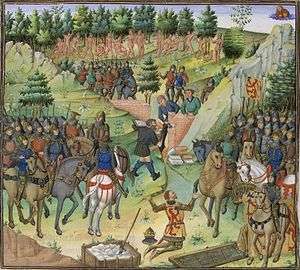
A legend was attached to Gog and Magog by the time of the Roman period, that the Gates of Alexander were erected by Alexander the Great to repel the tribe. Romanized Jewish historian Josephus knew them as the nation descended from Magog the Japhetite, as in Genesis, and explained them to be the Scythians. In the hands of Early Christian writers they became apocalyptic hordes, and throughout the Medieval period variously identified as the Vikings, Huns, Khazars, Mongols, Turanians or other nomads, or even the Ten Lost Tribes of Israel.
The legend of Gog and Magog and the gates were also interpolated into the Alexander romances. In one version, "Goth and Magothy" are kings of the Unclean Nations, driven beyond a mountain pass by Alexander, and blocked from returning by his new wall. Gog and Magog are said to engage in human cannibalism in the romances and derived literature. They have also been depicted on Medieval cosmological maps, or mappae mundi, sometimes alongside Alexander's wall.
The conflation of Gog and Magog with the legend of Alexander and the Iron Gates was disseminated throughout the Near East in the early centuries of the Christian and Islamic era.[4] They appear in the Quran in chapter Al-Kahf as Yajuj and Majuj (Arabic: يَأْجُوجُ وَمَأْجُوجُ; Yaʾjūj wa-Maʾjūj), primitive and immoral tribes that were separated and barriered off by Dhul-Qarnayn (possessor of the Two Horns), who is mentioned in the Quran as a great righteous ruler and conqueror.[5] Many modern Muslim historians and geographers regarded the Vikings as the emergence of Gog and Magog.[6] In contemporary times they remain associated with apocalyptic thinking, especially in Israel and the Muslim world.
The names Gog and Magog
| Part of a series on |
| Eschatology |
|---|
|
|
|
— Figures —
— Events — |
|
The names are mentioned together in Ezekiel chapter 38, where Gog is an individual and Magog is his land.[1] The meaning of the name Gog remains uncertain, and in any case, the author of the Ezekiel prophecy seems to attach no particular importance to it.[1] Efforts have been made to identify him with various individuals, notably Gyges, a king of Lydia in the early 7th century BC, but many scholars do not believe he is related to any historical person.[1]
In Genesis 10 Magog is a person, son of Japheth son of Noah, but no Gog is mentioned. The name Magog is equally obscure, but may come from the Assyrian mat-Gugu, "Land of Gyges", i.e., Lydia.[7] Alternatively, Gog may be derived from Magog rather than the other way round, and "Magog" may be code for Babylon.[lower-alpha 1][8][9][10]
The form "Gog and Magog" may have emerged as shorthand for "Gog and/of the land of Magog", based on their usage in the Septuagint, the Greek translation of the Hebrew Bible.[11] An example of this combined form in Hebrew (Gog u-Magog) has been found, but its context is unclear, being preserved only in a fragment of the Dead Sea Scrolls.[lower-alpha 2][12] In Revelation, Gog and Magog together are the hostile nations of the world.[13][3] Gog or Goug the Reubenite[lower-alpha 3] occurs in 1 Chronicles 5:4, but he appears to have no connection with the Gog of Ezekiel or Magog of Genesis.[15]
The Biblical "Gog and Magog" possibly gave derivation of the name Gogmagog, a legendary British giant.[lower-alpha 4][16] A later corrupted folk rendition in print altered the tradition around Gogmagog and Corineus with two giants Gog and Magog, with whom the Guildhall statues came to be identified.[17]
Christian texts
| Christian eschatology |
|---|
|
Contrasting beliefs |
|
Key terms
|
| Christianity portal |
In Ezekiel and the Old Testament
The Book of Ezekiel records a series of visions received by the prophet Ezekiel, a priest of Solomon's Temple, who was among the captive during the Babylonian exile. The exile, he tells his fellow captives, is God's punishment on Israel for turning away, but God will restore his people to Jerusalem when they return to him.[18] After this message of reassurance, chapters 38–39, the Gog oracle, tell how Gog of Magog and his hordes will threaten the restored Israel but will be destroyed, after which God will establish a new Temple and dwell with his people for a period of lasting peace (chapters 40–48).[19]
"Son of man, direct your face against Gog, of the land of Magog, the prince, leader of Meshech and Tubal, and prophesy concerning him. Say: Thus said the Lord: Behold, I am against you, Gog, the prince, leader of Meshech and Tubal ... Persia, Cush and Put will be with you ... also Gomer with all its troops, and Beth Togarmah from the far north with all its troops—the many nations with you."[20]
Internal evidence indicates that the Gog oracle was composed substantially later than the chapters around it.[lower-alpha 5][21]Of Gog's allies, Meshech and Tubal were 7th-century BC kingdoms in central Anatolia north of Israel, Persia towards east, Cush (Ethiopia) and Put (Libya) to the south; Gomer is the Cimmerians, a nomadic people north of the Black Sea, and Beth Togarmah was on the border of Tubal.[22] The confederation thus represents a multinational alliance surrounding Israel.[23] "Why the prophet's gaze should have focused on these particular nations is unclear," comments Biblical scholar Daniel I. Block, but their remoteness and reputation for violence and mystery possibly "made Gog and his confederates perfect symbols of the archetypal enemy, rising against God and his people".[24] One explanation is that the Gog alliance, a blend of the "Table of Nations" in Genesis 10 and Tyre's trading partners in Ezekiel 27, with Persia added, was cast in the role of end-time enemies of Israel by means of Isaiah 66:19, which is another text of eschatological foretelling.[25]
Although the prophecy refers to Gog as an enemy in some future, it is not clear if the confrontation is meant to occur in a final "end of days" since the Hebrew term aḥarit ha-yamim (Hebrew: אחרית הימים) may merely mean "latter days", and is open to interpretation. Twentieth-century scholars have used the term to denote the eschaton in a malleable sense, not necessarily meaning final days, or tied to the Apocalypse.[lower-alpha 6][26] Still, the Utopia of chapters 40–48 can be spoken of in the parlance of "true eschatological character, given that it is a product of "cosmic conflict" described in the immediately preceding Gog chapters.[27]
The Septuagint reads "Agag" instead of "Gog" in Numbers 24:7.
Gog and Magog from Ezekiel to Revelation
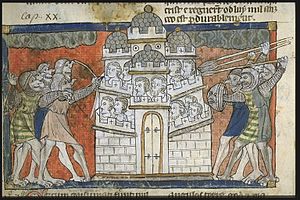
—Old French Apocalypse in verse, Toulouse MS. 815, fol. 49v
_64_-_O_Goze_i_Magoze.jpg)
Over the next few centuries Jewish tradition changed Ezekiel's Gog from Magog into Gog and Magog.[2] The process, and the shifting geography of Gog and Magog, can be traced through the literature of the period. The 3rd book of the Sibylline Oracles, for example, which originated in Egyptian Judaism in the middle of the 2nd century BC,[29] changes Ezekiel's "Gog from Magog" to "Gog and Magog", links their fate with up to eleven other nations, and places them "in the midst of Aethiopian rivers"; this seems a strange location, but ancient geography did sometimes place Ethiopia next to Persia or even India.[30] The passage has a highly uncertain text, with manuscripts varying in their groupings of the letters of the Greek text into words, leading to different readings; one group of manuscripts ("group Y") links them with the "Marsians and Dacians", in eastern Europe, amongst others.[31]
The Book of Jubilees, from about the same time, makes three references to either Gog or Magog: in the first, Magog is a descendant of Noah, as in Genesis 10; in the second, Gog is a region next to Japheth's borders; and in the third, a portion of Japheth's land is assigned to Magog.[32] The 1st-century Liber Antiquitatum Biblicarum, which retells Biblical history from Adam to Saul, is notable for listing and naming seven of Magog's sons, and mentions his "thousands" of descendants.[33] The Samaritan Torah and the Septuagint (a Greek translation of the Hebrew Bible made during the last few centuries of the pre-Christian era) occasionally introduce the name of Gog where the Hebrew original has something else, or use Magog where the Hebrew has Gog, indicating that the names were interchangeable.[34]
Chapters 19:11–21:8 of the Book of Revelation, dating from the end of the 1st century AD,[35] tells how Satan is to be imprisoned for a thousand years, and how, on his release, he will rally "the nations in the four corners of the Earth, Gog and Magog", to a final battle with Christ and his saints:[3]
When the thousand years are over, Satan will be released from his prison and will go out to deceive the nations in the four corners of the Earth—Gog and Magog—and to gather them for battle. In number they are like the sand on the seashore.[36]
Jewish texts
Midrashic writings
The anti-Roman Bar Kokhba revolt in the 2nd century AD looked to a human leader as the promised messiah, but after its failure Jews began to conceive of the messianic age in supernatural terms: first would come a forerunner, the Messiah ben Joseph, who would defeat Israel's enemies, identified as Gog and Magog, to prepare the way for the Messiah ben David;[lower-alpha 7] then the dead would rise, divine judgement would be handed out, and the righteous would be rewarded.[38][39]
The aggadah, homiletic and non-legalistic exegetical texts in the classical rabbinic literature of Judaism, treat Gog and Magog as two names for the same nation who will come against Israel in the final war.[40] The rabbis associated no specific nation or territory with them beyond a location to the north of Israel,[41] but the great Jewish scholar Rashi identified the Christians as their allies and said God would thwart their plan to kill all Israel.[42]
Alexander the Great
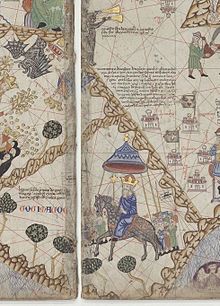
The 1st-century Jewish historian Josephus identified the Gog and Magog people as Scythians, horse-riding barbarians from around the Don and the Sea of Azov. Josephus recounts the tradition that Gog and Magog were locked up by Alexander the Great behind iron gates in the "Caspian Mountains", generally identified with the Caucasus Mountains. This legend must have been current in contemporary Jewish circles by this period, coinciding with the beginning of the Christian Era.[lower-alpha 8][46] Several centuries later, this material was vastly elaborated in the Apocalypse of Pseudo-Methodius and Alexander romance.[47]
Precursor texts in Syriac
The Pseudo-Methodius, written originally in Syriac, is considered the source of Gog and Magog tale incorporated into Western versions of the Alexander Romance.[48][49] An earlier-dated Syriac Alexander Legend contains a somewhat different treatment of the Gog and Magog material, which passed into the lost Arabic version,[50] or the Ethiopic and later Oriental versions of the Alexander romance.[51][lower-alpha 9]
In the Syriac Alexander Legend dating to 629–630, Gog (Syriac: ܓܘܓ, gwg) and Magog (Syriac: ܡܓܘܓܵ, mgwg) appear as kings of Hunnish nations.[lower-alpha 10][52] Written by a Christian based in Mesopotamia, the Legend is considered the first work to connect the Gates with the idea that Gog and Magog are destined to play a role in the apocalypse.[53] The legend claims that Alexander carved prophecies on the face of the Gate, marking a date for when these Huns, consisting of 24 nations, will breach the Gate and subjugate the greater part of the world.[lower-alpha 11][54][55]
Pseudo-Methodius (7th century[56]) is the first source in the Christian tradition for a new element: two mountains moving together to narrow the corridor, which was then sealed with a gate against Gog and Magog. This idea is also in the Quran (609–632 CE[57][58]), and found its way in the Western Alexander Romance.[59]
Alexander romances
This Gog and Magog legend is not found in earlier versions of the Alexander romance of Pseudo-Callisthenes, whose oldest manuscript dates to the 3rd century,[lower-alpha 12] but an interpolation into recensions around the 8th century.[lower-alpha 13][61] In the latest and longest Greek version[lower-alpha 14] are described the Unclean Nations, which include the Goth and Magoth as their kings, and whose people engage in the habit of eating worms, dogs, human cadavers and fetuses.[62] They were allied to Belsyrians (Bebrykes,[63] of Bithynia in modern-day North Turkey), and sealed beyond the "Breasts of the North", a pair of mountains fifty days' march away towards the north.[lower-alpha 15][62]
Gog and Magog appear in somewhat later Old French versions of the romance.[lower-alpha 16][64] In the verse Roman d'Alexandre, Branch III, of Lambert le Tort (c. 1170), Gog and Magog ("Gos et Margos", "Got et Margot") were vassals to Porus, king of India, providing an auxiliary force of 400,000 men.[lower-alpha 17] Routed by Alexander, they escaped through a defile in the mountains of Tus (or Turs),[lower-alpha 18] and were sealed by the wall erected there, to last until the advent of the Antichrist.[lower-alpha 19][65][66] Branch IV of the poetic cycle tells that the task of guarding Gog and Magog, as well as the rule of Syria and Persia was assigned to Antigonus, one of Alexander's successors.[67]
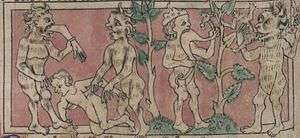
—Thomas de Kent's Roman de toute chevalerie, Paris manuscript, 14th century
Gog and Magog also appear in Thomas de Kent's Roman de toute chevalerie (c. 1180), where they are portrayed as cave-dwellers who consume human flesh. A condensed account occurs in a derivative work, the Middle English King Alisaunder (vv. 5938–6287).[68][69][70] In the 13th-century French Roman d'Alexandre en prose, Alexander has an encounter with cannibals who have taken over the role of Gog and Magog.[71] This is a case of imperfect transmission, since the prose Alexander's source, the Latin work by Archpriest Leo of Naples known as Historia de Preliis, does mention "Gogh et Macgogh", at least in some manuscripts.[72]
The Gog and Magog are not only human flesh-eaters, but illustrated as men "a notably beaked nose" in examples such as the "Henry of Mainz map", an important example of mappa mundi.[73] Gog and Magog caricaturised as figures with hooked noses on a miniature depicting their attack of the Holy City, found in a manuscript of the Apocalypse in Anglo-Norman.[lower-alpha 20][28]
Identification with civilisations
Early Christian writers (e.g. Eusebius) frequently identified Gog and Magog with the Romans and their emperor.[74] After the Empire became Christian, Ambrose (d. 397) identified Gog with the Goths, Jerome (d. 420) with the Scythians, and Jordanes (died c. 555) said that Goths, Scythians and Amazons were all the same; he also cited Alexander's gates in the Caucasus.[75][lower-alpha 21] The Byzantine writer Procopius said it was the Huns Alexander had locked out, and a Western monk named Fredegar seems to have Gog and Magog in mind in his description of savage hordes from beyond Alexander's gates who had assisted the Byzantine emperor Heraclius (610–641) against the Muslim Saracens.[77]
Nomadic identification
As one nomadic people followed another on the Eurasian steppes, so the identification of Gog and Magog shifted. In the 9th and 10th centuries these kingdoms were identified by some with the lands of the Khazars, a Turkic people who had converted to Judaism and whose empire dominated Central Asia–the 9th-century monk Christian of Stavelot referred to Gazari, said of the Khazars that they were "living in the lands of Gog and Magog" and noted that they were "circumcised and observing all [the laws of] Judaism".[78][79] Arab traveler ibn Fadlan also reported of this belief, writing around 921 he recorded that "Some hold the opinion that Gog and Magog are the Khazars".[80]
After the Khazars came the Mongols, seen as a mysterious and invincible horde from the east who destroyed Muslim empires and kingdoms in the early 13th century; kings and popes took them for the legendary Prester John, marching to save Christians from the Muslim Saracens, but when they entered Poland and Hungary and annihilated Christian armies a terrified Europe concluded that they were "Magogoli", the offspring of Gog and Magog, released from the prison Alexander had constructed for them and heralding Armageddon.[81]
Europeans in Medieval China reported findings from their travels to the Mongol Empire. Some accounts and maps began to place the "Caspian Mountains", and Gog and Magog, just outside the Great Wall of China. The Tartar Relation, an obscure account of Friar Carpini's 1240s journey to Mongolia, is unique in alleging that these Caspian Mountains in Mongolia, "where the Jews called Gog and Magog by their fellow countrymen are said to have been shut in by Alexander", were moreover purported by the Tartars to be magnetic, causing all iron equipment and weapons to fly off toward the mountains on approach.[82] In 1251, the French friar André de Longjumeau informed his king that the Mongols originated from a desert further east, and an apocalyptic Gog and Magog ("Got and Margoth") people dwelled further beyond, confined by the mountains.[83]
In fact, Gog and Magog were held by the Mongol to be their ancestors, at least by some segment of the population. As traveler and Friar Riccoldo da Monte di Croce put it in c. 1291, "They say themselves that they are descended from Gog and Magog: and on this account they are called Mogoli, as if from a corruption of Magogoli".[84][85][86] Marco Polo, traveling when the initial terror had subsided, places Gog and Magog among the Tartars in Tenduc, but then claims that the names Gog and Magog are translations of the place-names Ung and Mungul, inhabited by the Ung and Mongols respectively.[87][88]
An explanation offered by Orientalist Henry Yule was that Marco Polo was only referring to the "Rampart of Gog and Magog", a name for the Great Wall of China.[89] Friar André's placement of Gog and Magog far east of Mongolia has been similarly explained.[83]
The confined Jews
Some time around the 12th century, the Ten Lost Tribes of Israel came to be identified with Gog and Magog;[90] possibly the first to do so was Petrus Comestor in Historica Scholastica (c. 1169–1173),[91][92] and he was indeed a far greater influence than others before him, although the idea had been anticipated by the aforementioned Christian of Stavelot, who noted that the Khazhars, to be identified with Gog and Magog, was one of seven tribes of the Hungarians and had converted to Judaism.[78][79]
While the confounding Gog and Magog as confined Jews was becoming commonplace, some, like Riccoldo or Vincent de Beauvais remained skeptics, and distinguished the Lost Tribes from Gog and Magog.[84][93][94] As noted, Riccoldo had reported a Mongol folk-tradition that they were descended from Gog and Magog. He also addressed many minds (Westerners or otherwise[95]) being credulous of the notion that Mongols might be Captive Jews, but after weighing the pros and cons, he concluded this was an open question.[lower-alpha 22][86][96]
The Flemish Franciscan friar William of Rubruck, who was first-hand witness to Alexander's supposed wall in Derbent on the shores of the Caspian Sea in 1254,[lower-alpha 23] identified the people the walls were meant to fend off only vaguely as "wild tribes" or "desert nomads",[lower-alpha 24][99] but one researcher made the inference Rubruck must have meant Jews,[lower-alpha 25] and that he was speaking in the context of "Gog and Magog".[lower-alpha 26][95] Confined Jews were later to be referred to as "Red Jews" (die roten Juden) in German-speaking areas; a term first used in a Holy Grail epic dating to the 1270s, in which Gog and Magog were two mountains enclosing these people.[lower-alpha 27][100]
The author of the Travels of Sir John Mandeville, a 14th-century best-seller, said he had found these Jews in Central Asia where as Gog and Magog they had been imprisoned by Alexander, plotting to escape and join with the Jews of Europe to destroy Christians.[101]
In Islamic tradition
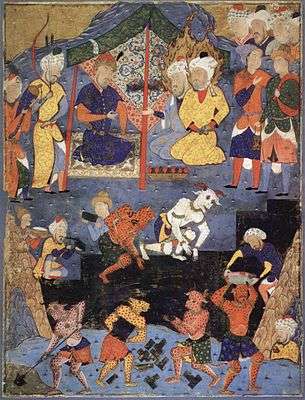
Two chapters Al Kahf and Al-Anbiya of the Quran discuss Gog and Magog. In the Quran Yajuj and Majuj (Gog and Magog) are suppressed by Dhul-Qarnayn "the two-horned one", a figure derived from Alexander the Great.[5] Dhul-Qarnayn, having journeyed to the ends of the world, meets "a people who scarcely understood a word" who seek his help in building a barrier that will separate them from the people of Yajuj and Majuj who "do great mischief on earth". He agrees to build it for them, but warns that when the time comes (Last Age), Allah will remove the barrier.[104]
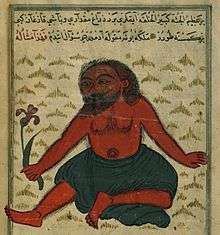
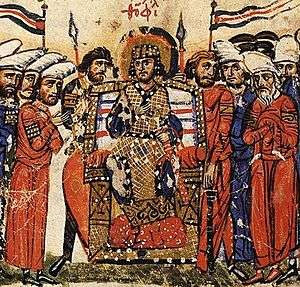
The early Muslim traditions were summarised by Zakariya al-Qazwini (d. 1283) in two popular works called the Cosmography and the Geography. Gog and Magog, he says, live near to the sea that encircles the Earth and can be counted only by God; they are only half the height of a normal man, with claws instead of nails and a hairy tail and huge hairy ears which they use as mattress and cover for sleeping.[105] They scratch at their wall each day until they almost break through. They break for the night saying tomorrow we will finish, and each night God restores it. Then one day, as they stop scratching for the night, one will say tomorrow we will finish God Willing, and in the morning, it is not restored as with everything night. When they do break through they will be so numerous that "their vanguard is in Syria and their rear in Khorasan".[106]
Various nations and peoples in history were identified as Ya'juj and Ma'juj. At one point, it was the Turks, who threatened Baghdad and northern Iran;[107] later, when the Mongols destroyed Baghdad in 1258, it was they who were Gog and Magog.[108] The wall dividing them from civilised peoples was normally placed towards Armenia and Azerbaijan, but in the year 842 the Caliph Al-Wathiq had a dream in which he saw that it had been breached, and sent an official named Sallam to investigate may be related Ergenekon.[109] Sallam returned a little over two years later and reported that he had seen the wall and also the tower where Dhul Qarnayn had left his building equipment, and all was still intact.[110] It is not entirely clear what Sallam saw, but he may have reached the Jade Gate and the westernmost customs point on the border of China.[111] Somewhat later the 14th-century traveller Ibn Battuta reported that the wall was sixty days' travel from the city of Zeitun, which is on the coast of China; the translator notes that Ibn Battuta has confused the Great Wall of China with that built by Dhul-Qarnayn.[112]
According to Shia sources, Yajooj and Majooj are not from the Children of Adam (the human race). Al-Kafi, one of their primary collections of ahadith, states that it has been narrated from Ibn Abbas that when he asked Ali about the "creatures", he responded by saying God has created "1,200 species on the land, 1,200 species in the sea, 70 species from the Children of Adam and the people are the Children of Adam except for the Yajooj and Majooj".[113] This is in contradiction with many reports in Sunni sources, including those in Sahih Al-Bukhari and Sahih Muslim, which indicate they will indeed, be from the Children of Adam, and this is the belief of the overwhelming majority of Islamic scholars. [114]
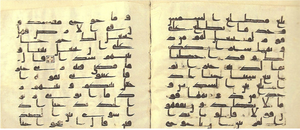
Various modern scholars of history and geography regarded the Vikings and their descendants as Gog and Magog, since the unknown group from Scandinavia had made their sudden and considerable entry into the history of Europe.[6] Viking travellers and colonists were seen at many points in history as violent raiders. Many historical documents suggest that their conquests of other territories was retaliation in response to the encroachment upon tribal lands by Christian missionaries, and perhaps by the Saxon Wars prosecuted by Charlemagne and his kin to the south.[115][116][117][118][119] Researches of professors and philosophers such as Allama Muhammad Iqbal, Syeed Abul Ala Mawdudi, who played important roles in British and South Asian politics, and American academic Abu Ammaar Yasir Qadhi and Caribbean eschatologist Imran N. Hosein, compare the languages, behaviours and sexual activities of the tribes of Gog and Magog with those of Vikings.[120][121][122][123][124]
%2C_Northern_Israel.jpg)
According to Sahih Muslim, the Prophet said:
Then a people whom Allah had protected from him (dajjal) would come to Isa, son of Maryam (alaihimas salam), and he would wipe their faces and would inform them of their ranks in Paradise and it would be under such conditions that Allah would reveal to Isa (alaihis salam) these words: I have brought forth from amongst My servants such people against whom none would be able to fight; you take these people safely to Tur, and then Allah would send Gog and Magog and they would swarm down from every slope. The first of them would pass the lake of Tiberias and drink out of it. And when the last of them would pass, he would say: There was once water there.
Some scholars further attempt to relate the last portion of the interpretation of Yajuj and Majuj to the lake of Tiberias, currently known as the Sea of Galilee, the Earth's lowest freshwater lake, and the Dead Sea.[125]
Historian and exegete Ibn Kathir mentioned similar theories in his book Al-Bidaya wa'l-Nihaya.[126]
In Ahmadiyya
Mirza Ghulam Ahmad (d.1908), the founder of the Ahmadiyya movement, identified Gog and Magog with the European powers that had emerged from the Slavic and Germanic peoples respectively, with particular reference to their political duplicity and shattering of world peace.[127][128][129][130] Ahmadiyya exegeses draw upon the etymological connection of the Arabic cognate Yaʾjūj wa-Maʾjūj with the underlying themes of blazing fire, hastiness and boiling water to what is viewed as the superlative industrial use of fire and steam by these peoples and to their restless political character.[130][131] According to these teachings, the conflict between Russia and the United States as two superpowers, or the militant rivalry between the communist and capitalist systems and their impact over the nations of the world, is thus seen as having occurred in accordance with prophecies concerning Gog and Magog.[131][132] These powers cannot be defeated through military force and are to be overcome through prayer and divine intervention.[133] Islam is then seen as that which alone would succeed in bringing people of different nations together as per the Quran (18:99).[127]
Modern apocalypticism
In the early 19th century, some Chasidic rabbis identified the French invasion of Russia under Napoleon as "The War of Gog and Magog".[134] But as the century progressed, apocalyptic expectations receded as the populace in Europe began to adopt an increasingly secular worldview.[135] This has not been the case in the United States, where a 2002 poll indicated that 59% of Americans believed the events predicted in the Book of Revelation would come to pass.[136] During the Cold War the idea that Soviet Russia had the role of Gog gained popularity, since Ezekiel's words describing him as "prince of Meshek"—rosh meshek in Hebrew—sounded suspiciously like Russia and Moscow.[18] Even some Russians took up the idea, apparently unconcerned by the implications ("Ancestors were found in the Bible, and that was enough"), as did Ronald Reagan.[137][138]
Some post-Cold War millenarians still identify Gog with Russia, but they now tend to stress its allies among Islamic nations, especially Iran.[139] For the most fervent, the countdown to Armageddon began with the return of the Jews to Israel, followed quickly by further signs pointing to the nearness of the final battle—nuclear weapons, European integration, Israel's reunification of Jerusalem in the Six Day War in 1967, and America's wars in Afghanistan and the Persian Gulf.[140] US President George W. Bush, in the prelude to the 2003 Invasion of Iraq, Bush told French President Jacques Chirac, "Gog and Magog are at work in the Middle East." Bush is said to have continued, "This confrontation is willed by God, who wants to use this conflict to erase His people's enemies before a new age begins."[141] Officials from the Bush Administration claim there is no record of this conversation and that making such references, "doesn't sound at all like Bush."[142]
In the Islamic apocalyptic tradition, the end of the world would be preceded by the release of Gog and Magog, whose destruction by God in a single night would usher in the Day of Resurrection.[143] Reinterpretation did not generally continue after Classical times, but the needs of the modern world have produced a new body of apocalyptic literature in which Gog and Magog are identified as Communist Russia and China.[144] One problem these writers have had to confront is the barrier holding Gog and Magog back, which is not to be found in the modern world: the answer varies, some writers saying that Gog and Magog were the Mongols and that the wall is now gone, others that both the wall and Gog and Magog are invisible.[145]
See also
| Wikimedia Commons has media related to Gog and Magog. |
- Alexander the Great in the Quran
- Eschatology
- Magog
- Cyrus the Great in the Quran
- Sasanian defence lines
- Ergenekon
Explanatory notes
- The encryption technique is called atbash. BBL ("Babylon") when read backwards and displaced by one letter becomes MGG (Magog).
- 4Q523 scroll
- All Reubenites are held to be descendants of Reuben in the view of the Torah, but it is unclear what family relationship Gog's father Joel has with the sons of Reuben in verse 3.[14]
- The giant mentioned by Geoffrey of Monmouth in Historia Regum Britanniae (1136 AD).
- Composed between the 4th and 2nd centuries BC
- Tooman's view is that the "latter days" means "the end of history-as-we-know-it and the initiation of a new historical age".
- The coming of the Messiah ben David "is contemporary with or just after that of Messiah ben Joseph" (van der Woude (1974), p. 527).[37]
- Josephus, Antiquities of the Jews 1.123 and 18.97; The Jewish War 7.244–51
- The Ethiopic version derives from the lost Arabic version (Boyle 1979, p. 133). While Budge 1889 does not appear to comment, cf. Budge (1896), The Life and Exploits of Alexander, p. 216, fn 1.
- Also called Christian Legend concerning Alexander, ed. tr. by E. A. Wallis Budge. It has a long full-title, which in shorthand reads "An exploit of Alexander.. how.. he made a gate of iron, and shut it [against] the Huns".
- The first invasion, prophesied to occur 826 years after Alexander predicted, has been worked out to fall on 1 October 514; the second invasion on A.D. 629 (Boyle 1979, p. 124).
- The oldest manuscript is recension α. The material is not found in the oldest Greek, Latin, Armenian, and Syriac versions.[60]
- Recension ε
- Recension γ
- Alexander's prayer caused the mountains to move nearer, making the pass narrower, facilitating his building his gate. This is the aforementioned element first seen in pseudo-Methodius.
- Gog and Magog being absent in the Alexandreis (1080) of Walter of Châtillon.
- Note the change in loyalties. According to the Greek version, Gog and Magog served the Belsyrians, whom Alexander fought them after completing his campaign against Porus.
- "Tus" in Iran, near the Caspian south shore, known as Susia to the Greeks, is a city in the itinerary of the historical Alexander. Meyer does not make this identification, and suspects a corruption of mons Caspius etc.
- Branch III, laisses 124–128.
- Toulouse manuscript 815, folio 49v.
- The idea that Gog and Magog were connected with the Goths was longstanding; in the mid-16th century, Archbishop of Uppsala Johannes Magnus traced the royal family of Sweden back to Magog son of Japheth, via Suenno, progenitor of the Swedes, and Gog, ancestor of the Goths).[76]
- Riccoldo observed that the Mongol script resembled Chaldean (Syriac,[96] a form of Aramaic), and in fact it does derive from Aramaic.[97] However, he saw that Mongols bore no physical resemblance to Jews and were ignorant of Jewish laws.
- Rubruck refers Derbent as the "Iron Gate", this also being the meaning of the Turkish name (Demir kapi) for the town.[98] Rubruck may have been the only medieval Westerner to claim to have seen it.[95]
- Also "barbarous nations", "savage tribes".
- Based on Rubruck stating elsewhere "There are other enclosures in which there are Jews"
- Since Roger Bacon, having been informed by Rubruck, urged the study of geography to discover where the Antichrist and Gog and Magog might be found.
- Albrecht von Scharfenberg, Der jüngere Titurel. It belongs in the Arthurian cycle.
References
Citations
- Lust 1999b, pp. 373–374.
- Boring, Eugene M (1989). Revelation. Westminster John Knox. p. 209. ISBN 9780664237752.
- Mounce, Robert H (1998). The Book of Revelation. Eerdmans. ISBN 9780802825377.
- Bietenholz 1994, p. 123.
- Van Donzel & Schmidt 2010, pp. 57, fn 3.
- Sawyer, P. H. (April 10, 1982). "Kings and Vikings: Scandinavia and Europe, A.D. 700-1100". Methuen – via Google Books.
- Gmirkin, Russell (2006). Berossus and Genesis, Manetho and Exodus: Hellenistic Histories and the Date of the Pentateuch. Bloomsbury. p. 148. ISBN 9780567134394.
- Lust 1999a, p. 536.
- Bøe 2001, p. 84, fn. 31.
- Lust (1999a) and Bøe (2001) cite Brownlee (1983) "Son of Man Set Your Face: Ezekiel the Refugee Prophet", HUCA 54.
- Buitenwerf 2007, p. 166.
- Buitenwerf 2007, p. 172.
- Bøe 2001, pp. 89–90.
- Bøe 2001, p. 49.
- Bøe 2001, p. 1.
- Simpson, Jacqueline; Roud, Stephen (2000), Oxford Dictionary of English Folklore, Oxford University Press, Gogmagog (or Gog and Magog), ISBN 9780192100191
- Fairholt, Frederick William (1859), Gog and Magog: The Giants in Guildhall; Their Real and Legendary History, John Camden Hotten, pp. 8–11, 130
- Blenkinsopp 1996, p. 178.
- Bullock, C. Hassell (1986). An Introduction to the Old Testament Prophetic Books. Chicago: Moody Press. p. 301. ISBN 9781575674360.
- Ezekiel 38 (NRSV)
- Tooman 2011, p. 271.
- Block 1998, pp. 72–73, 439–440.
- Hays, J. Daniel; Duvall, J. Scott; Pate, C. Marvin (2009). Dictionary of Biblical Prophecy and End Times. Zondervan. p. no pagination. ISBN 9780310571049.
- Block 1998, p. 436.
- Tooman 2011, pp. 147–148.
- Tooman 2011, pp. 94–97.
- Petersen, David L. (2002). The prophetic literature: an introduction. John Knox Press. p. 158. ISBN 9780664254537.
- Meyer, Paul (1896), "Version anglo-normande en vers de l'Apocalypse", Romania, 25 (98): 176 (plate), and 246, p. 257 note 2, doi:10.3406/roma.1896.5446
- Wardle, Timothy (2010). The Jerusalem Temple and Early Christian Identity. Mohr Siebeck. p. 89. ISBN 9783161505683.
- Bøe 2001, pp. 142–144.
- Bøe 2001, pp. 145–146.
- Bøe 2001, p. 153.
- Bøe 2001, pp. 186–189.
- Lust 1999a, pp. 536–537.
- Stuckenbruck, Loren T. (2003). "Revelation". In Dunn, James D. G.; Rogerson, John William (eds.). Eerdmans Commentary on the Bible. Eerdmans. pp. 1535–36. ISBN 9780802837110.
- Revelation 20:7–10 (NIV)
- Bøe 2001, p. 201.
- Schreiber, Mordecai; Schiff, Alvin I.; Klenicki, Leon (2003). "Messianism". In Schreiber, Mordecai; Schiff, Alvin I.; Klenicki, Leon (eds.). The Shengold Jewish Encyclopedia. Rockville, Maryland: Schreiber Publishing. p. 180. ISBN 9781887563772.
- Bøe 2001, pp. 201–204.
- Skolnik & Berenbaum 2007, p. 684.
- Mikraot Gedolot HaMeor p. 400
- Grossman, Avraham (2012). "The Commentary of Rashi on Isaiah and the Jewish-Christian Debate". In Wolfson, Elliot R.; Schiffman, Lawrence H.; Engel, David (eds.). Studies in Medieval Jewish Intellectual and Social History. Brill. p. 54. ISBN 9789004222366.
- Westrem 1998, pp. 61–62.
- Massing 1991, pp. 31, 32 n60.
- Siebold, Jim (2015). "The Catalan Atlas (#235)". My Old Maps. Retrieved 2016-08-12.
- Bietenholz 1994, p. 122.
- Bietenholz 1994, pp. 122–125.
- Van Donzel & Schmidt 2010, p. 30.
- Stoneman 1991, p. 29.
- Boyle 1979, p. 123.
- Van Donzel & Schmidt 2010, p. 32.
- Budge 1889, II, p. 150.
- Van Donzel & Schmidt 2010, p. 17.
- Budge 1889, II, pp. 153–54.
- Van Donzel & Schmidt 2010, pp. 17–21.
- Griffith, Sidney Harrison (2008). The Church in the Shadow of the Mosque: Christians and Muslims in the World of Islam. Princeton, NJ: Princeton University Press. p. 34. ISBN 9780691130156.
- Fazlur Rehman Shaikh (2001). Chronology of Prophetic Events. Ta-Ha Publishers Ltd. p. 50.
- Living Religions: An Encyclopaedia of the World's Faiths, Mary Pat Fisher, 1997, page 338, I.B. Tauris Publishers.
- Van Donzel & Schmidt 2010, p. 21.
- Van Donzel & Schmidt 2010, pp. 17, 21.
- Stoneman 1991, pp. 28–32.
- Stoneman 1991, pp. 185–187.
- Anderson 1932, p. 35.
- Westrem 1998, p. 57.
- Armstrong 1937, VI, p. 41.
- Meyer 1886, summary of §11 (Michel ed., pp. 295–313), pp. 169–170; appendix II on Gog and Magog episode, pp. 386–389; on third branch, pp. 213, 214.
- Meyer 1886, p. 207.
- Anderson 1932, p. 88.
- Harf-Lancner, Laurence (2012), Maddox, Donald; Sturm-Maddox, Sara (eds.), "From Alexander to Marco Polo, from Text to Image: The Marvels of India", Medieval French Alexander, SUNY Press, p. 238, ISBN 9780791488324
- Akbari, Suzanne Conklin (2012), Idols in the East: European Representations of Islam and the Orient, 1100–1450, Cornell University Press, p. 104, ISBN 9780801464973
- Warren, Michelle R. (2012), Maddox, Donald; Sturm-Maddox, Sara (eds.), "Take the World by Prose: Modes of Possession in the Roman d'Alexandre", Medieval French Alexander, SUNY Press, pp. 149, fn 17, ISBN 9780791488324
- Michael 1982, p. 133.
- Westrem (1998), p. 61.
- Lust 1999b, p. 375.
- Bietenholz 1994, p. 125.
- Derry, T.K (1979). A History of Scandinavia: Norway, Sweden, Denmark, Finland, and Iceland. University of Minnesota Press. p. 129 (fn). ISBN 9780816637997.
- Bietenholz 1994, pp. 125–126.
- Brook 2006, pp. 7–8, 96.
- Westrem 1998, p. 65.
- Brook 2006, p. 8.
- Marshall 1993, pp. 12, 120–122, 144.
- Painter, George D. Painter, ed. (1965), The Tartar Relation, Yale University, pp. 64–65
- William of Rubruck & Rockhill (tr.) 1900, pp. xxi, fn 2.
- Boyle 1979, p. 126.
- Marco Polo & Yule (tr.) 1875, pp. 285, fn 5.
- Westrem 1998, pp. 66–67.
- Marco Polo & Yule (tr.) 1875, pp. 276–286.
- Strickland, Deborah Higgs (2008). "Text, Image and Contradiction in the Devisement du monde". In Akbari, Suzanne Conklin; Iannucci, Amilcare (eds.). Marco Polo and the Encounter of East and West. University of Toronto Press. p. 38. ISBN 9780802099280.
- Marco Polo & Yule (tr.) 1875, pp. 283, fn 5.
- Gow 1995, pp. 23–24.
- Gow 1995, p. 42.
- Boyle 1979, p. 124.
- Bietenholz 1994, p. 134.
- Gow 1995, pp. 56–57.
- Westrem 1998, p. 66.
- Marco Polo & Yule (tr.) 1875, pp. 58, fn 3.
- Boyle 1979, p. 125, note 19.
- William of Rubruck & Rockhill (tr.) 1900, pp. xlvi, 262 note 1.
- William of Rubruck & Rockhill (tr.) 1900, pp. xlvi, 100, 120, 122, 130, 262–263 and fn.
- Gow 1995, pp. 70–71.
- Westrem 1998, pp. 68–69.
- Chester Beatty Library. "Iskandar Oversees the Building of the Wall". image gallery. Retrieved 2016-08-24.
- Amín, Haila Manteghí (2014). La Leyenda de Alejandro segn el Šāhnāme de Ferdowsī. La transmisión desde la versión griega hast ala versión persa (PDF) (Ph. D). Universidad de Alicante. p. 196 and Images 14, 15.
- Hughes, Patrick Thomas (1895) [1885]. Dictionary of Islam. New Delhi: Asian Educational Services. ISBN 9788120606722.
- Van Donzel & Schmidt 2010, pp. 65–68.
- Van Donzel & Schmidt 2010, p. 74.
- Van Donzel & Schmidt 2010, pp. 82–84.
- Filiu 2011, p. 30.
- Van Donzel & Schmidt 2010, pp. xvii–xviii, 82.
- Van Donzel & Schmidt 2010, pp. xvii–xviii, 244.
- Van Donzel & Schmidt 2010, pp. xvii–xviii.
- Gibb, H.A.R.; Beckingham, C.F. (1994). The Travels of Ibn Baṭṭūṭa, A.D. 1325–1354 (Vol. IV). Hakluyt Society. pp. 896, fn 30. ISBN 9780904180374.
- al-Kulayni, Muhammad ibn Ya‘qūb (2015). Al-Kafi (Volume 8 ed.). Islamic Seminary Incorporated. ISBN 9780991430864.
- "Story of Ya'juj and Ma'juj (Gog and Magog) form The Quran - Link To Islam". www.linktoislam.net.
- Simek, Rudolf (2005) "the emergence of the viking age: circumstances and conditions", "The vikings first Europeans VIII – XI century – the new discoveries of archaeology", other, pp. 24–25
- Bruno Dumézil, master of Conference at Paris X–Nanterre, Normalien, aggregated history, author of conversion and freedom in the barbarian kingdoms. 5th – 8th centuries (Fayard, 2005)
- "Franques Royal Annals" cited in Sawyer, Peter (2001) The Oxford Illustrated History of the Vikings. ISBN 0-19-285434-8. p. 20
- Decaux, Alain and Castelot, André (1981) Dictionnaire d'histoire de France. Perrin. ISBN 2-7242-3080-9. pp. 184–85
- Boyer, R. (2008) Les Vikings: histoire, mythes, dictionnaire. R. Laffont. ISBN 978-2-221-10631-0. p. 96
- Lund, Niels "The Danish Empire and the End of the Viking Age", in Sawyer, History of the Vikings, pp. 167–81.
- The Royal Household, "Sweyn", The official Website of The British Monarchy, 15 March 2015, accessed 15 March 2015
- Lawson, M K (2004). "Cnut: England's Viking King 1016–35". The History Press Ltd, 2005, ISBN 978-0582059702.
- The Royal Household, "Canute The Great", The official Website of The British Monarchy, 15 March 2015, accessed 15 March 2015
- Badsey, S. Nicolle, D, Turnbull, S (1999). "The Timechart of Military History". Worth Press Ltd, 2000, ISBN 1-903025-00-1.
- Sahih Muslim, 2937, The Book of Tribulations and Portents of the Last Hour
- (Shahadat-ul-Qur’an, Ruhani Khazain, Volume 6, Pages 361-362
- Wessels 2013, pp. 214–215.
- "Review of Religions" (PDF). Review of Religions. 101 (4). April 2006. Archived from the original (PDF) on 2015-09-24.
- Muhammad Ali. (1992) The Antichrist and Gog and Magog, Ohio: Ahmadiyya Anjuman-i Ishāʿat-i Islām
- Mirza Ghulam Ahmad, (2005), The Essence of Islam, Vol. III, Tilford: Islam International, p.305
- Malik Ghulam Farid, et al. (1988) Al-Anbiya, The Holy Quran with English Translation and Commentary Vol. IV, pp.1718–20, Tilford: Islam International
- "Islam and Communism" (PDF).
- Mirza Tahir Ahmad, (1992), The Gulf Crisis and New World Order, Tilford: Islam International, pp.68–71
- Wessels 2013, p. 205.
- Kyle 2012, pp. 34–35.
- Filiu 2011, p. 196.
- Boyer, Paul (1992). When Time Shall Be No More: Prophecy Belief in Modern Culture. Belknap Press. p. 162. ISBN 9780674028616.
- Marsh, Christopher (2011). Religion and the State in Russia and China. A&C Black. p. 254. ISBN 9781441112477.
- Kyle 2012, p. 171.
- Kyle 2012, p. 4.
- Smith, Jean Edward (2016). Bush. Simon and Schuster. p. 339. ISBN 9781476741192.
- Inboden, Will. "It's Impossible to Count the Things Wrong With the Negligent, Spurious, Distorted New Biography of George W. Bush". Foreign Policy. Retrieved 2020-06-06.
The conversation is utterly and completely false. Bush never said these words to Chirac or anything of the sort to any other world leader. I have checked with multiple senior people with firsthand knowledge of the call Bush had with Chirac, and all confirmed that Bush never said anything remotely resembling those words...Anyone who knows Bush, or even knows anything about him, on hearing the Gog and Magog story would immediately think, 'That just doesn’t sound at all like Bush.'
- Cook 2005, pp. 8, 10.
- Cook 2005, pp. 12, 47, 206.
- Cook 2005, pp. 205–206.
Bibliography
- Monographs
- Anderson, Andrew Runni (1932). Alexander's Gate, Gog and Magog: And the Inclosed Nations. Mediaeval Academy of America.
- Bøe, Sverre (2001). Gog and Magog: Ezekiel 38–39 as Pre-text for Revelation 19,17–21 and 20,7–10. Mohr Siebeck. ISBN 9783161475207.
- Buitenwerf, Rieuwerd (2007). "The Gog and Magog Tradition in Revelation 20:8". In de Jonge, H. J.; Tromp, Johannes (eds.). The Book of Ezekiel and its Influence. Ashgate Publishing. ISBN 9780754655831.
- Michael, Ian (1982), "Typological Problems in Medieval Alexander Literature: The Enclosure of Gog and Magog", The Medieval Alexander Legend and Romance Epic: Essays in Honour of David J.A. Ross, Kraus International Publication, pp. 131–147, ISBN 9780527626006
- Tooman, William A. (2011). Gog of Magog: Reuse of Scripture and Compositional Technique in Ezekiel 38–39. Mohr Siebeck. ISBN 9783161508578.
- Van Donzel, Emeri J.; Schmidt, Andrea Barbara (2010). Gog and Magog in Early Eastern Christian and Islamic Sources: Sallam's Quest for Alexander's Wall. Brill. ISBN 978-9004174160.
- Westrem, Scott D. (1998). Tomasch, Sylvia; Sealy, Gilles (eds.). Against Gog and Magog. Text and Territory: Geographical Imagination in the European Middle Ages. University of Pennsylvania Press. ISBN 0812216350.
- Encyclopedias
- Lust, J. (1999a). "Magog". In Van der Toorn, Karel; Becking, Bob; Van der Horst, Pieter (eds.). Dictionary of deities and demons in the Bible. Brill. ISBN 9780802824912.
- Lust, J. (1999b). "Gog". In Van der Toorn, Karel; Becking, Bob; Van der Horst, Pieter (eds.). Dictionary of deities and demons in the Bible. Brill. ISBN 9780802824912.
- Skolnik, Fred; Berenbaum, Michael (2007). Encyclopaedia Judaica. 7. Granite Hill Publishers. p. 684. ISBN 9780028659350.
- Biblical studies
- Blenkinsopp, Joseph (1996). A History of Prophecy in Israel (revised and enlarged ed.). Westminster John Knox. ISBN 9780664256395.
- Block, Daniel I. (1998). The Book of Ezekiel: Chapters 25-48. Eerdmans. ISBN 9780802825360.
- Literary
- Armstrong, Edward C. (1937). The Medieval French Roman d'Alexandre. VI. Princeton University Press.
- Bietenholz, Peter G. (1994). Historia and Fabula: Myths and Legends in Historical Thought from Antiquity to the Modern Age. Brill. ISBN 9004100636.
- Boyle, John Andrew (1979), "Alexander and the Mongols", The Journal of the Royal Asiatic Society of Great Britain and Ireland, 111 (2): 123–136, doi:10.1017/S0035869X00135555, JSTOR 25211053
- Budge, Sir Ernest Alfred Wallis, ed. (1889). "A Christian Legend concerning Alexander". The History of Alexander the Great, Being the Syriac Version. II. Cambridge University Press. pp. 144–158.
- Meyer, Paul (1886). Alexandre le Grand dans la littérature française du moyen âge. F. Vieweg. p. 170.
- Stoneman, Richard (tr.), ed. (1991). The Greek Alexander Romance. Penguin. ISBN 9780141907116.
- Geography and ethnography
- Brook, Kevin A (2006). The Jews of Khazaria. Rowman & Littlefield. ISBN 9781442203020.
- Gow, Andrew Colin (1995). The Red Jews: Antisemitism in an Apocalyptic Age, 1200–1600. Brill. ISBN 9004102558.
- Marshall, Robert (1993). Storm from the East: from Genghis Khan to Khubilai Khan. University of California Press. pp. 6–12, 120–122, 144. ISBN 9780520083004.
- Massing, Michel (1991), Levenson, Jay A. (ed.), "Observations and Beliefs: The World of the Catalan Atlas", Circa 1492: Art in the Age of Exploration, Yale University Press, pp. 31, 32 n60, ISBN 0300051670
- Polo, Marco (1875), "Ch. 59: Concerning the Province of Tenduc, and the Descendants of Prester John", The Book of Sir Marco Polo, the Venetian, 1, Translated and editted by Henry Yule (2nd, revised ed.), J. Murray, pp. 276–286 (

- William of Rubruck (1900). Rockhill, William Woodville (ed.). The Journey of William of Rubruck to the Eastern Parts of the World, 1253–55. Hakluyt Society. pp. xlvi, 100, 120, 122, 130, 262–263 and fn.
- Modern apocalyptic thought
- Cook, David (2005). Contemporary Muslim Apocalyptic Literature. Syracuse University Press. ISBN 9780815630586.
- Filiu, Jean-Pierre (2011). Apocalypse in Islam. University of California Press. ISBN 9780520264311.
- Kyle, Richard G. (2012). Apocalyptic Fever: End-Time Prophecies in Modern America. Wipf and Stock Publishers. ISBN 9781621894100.
- Wessels, Anton (2013). The Torah, the Gospel, and the Qur'an: Three Books, Two Cities, One Tale. Eerdmans. ISBN 9780802869081.
_-_Walters_44616_(cropped).jpg)